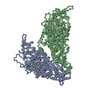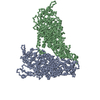+Search query
-Structure paper
| Title | High-resolution comparative atomic structures of two Giardiavirus prototypes infecting G. duodenalis parasite. |
|---|---|
| Journal, issue, pages | PLoS Pathog, Vol. 20, Issue 4, Page e1012140, Year 2024 |
| Publish date | Apr 10, 2024 |
 Authors Authors | Han Wang / Gianluca Marucci / Anna Munke / Mohammad Maruf Hassan / Marco Lalle / Kenta Okamoto /    |
| PubMed Abstract | The Giardia lamblia virus (GLV) is a non-enveloped icosahedral dsRNA and endosymbiont virus that infects the zoonotic protozoan parasite Giardia duodenalis (syn. G. lamblia, G. intestinalis), which ...The Giardia lamblia virus (GLV) is a non-enveloped icosahedral dsRNA and endosymbiont virus that infects the zoonotic protozoan parasite Giardia duodenalis (syn. G. lamblia, G. intestinalis), which is a pathogen of mammals, including humans. Elucidating the transmission mechanism of GLV is crucial for gaining an in-depth understanding of the virulence of the virus in G. duodenalis. GLV belongs to the family Totiviridae, which infects yeast and protozoa intracellularly; however, it also transmits extracellularly, similar to the phylogenetically, distantly related toti-like viruses that infect multicellular hosts. The GLV capsid structure is extensively involved in the longstanding discussion concerning extracellular transmission in Totiviridae and toti-like viruses. Hence, this study constructed the first high-resolution comparative atomic models of two GLV strains, namely GLV-HP and GLV-CAT, which showed different intracellular localization and virulence phenotypes, using cryogenic electron microscopy single-particle analysis. The atomic models of the GLV capsids presented swapped C-terminal extensions, extra surface loops, and a lack of cap-snatching pockets, similar to those of toti-like viruses. However, their open pores and absence of the extra crown protein resemble those of other yeast and protozoan Totiviridae viruses, demonstrating the essential structures for extracellular cell-to-cell transmission. The structural comparison between GLV-HP and GLV-CAT indicates the first evidence of critical structural motifs for the transmission and virulence of GLV in G. duodenalis. |
 External links External links |  PLoS Pathog / PLoS Pathog /  PubMed:38598600 / PubMed:38598600 /  PubMed Central PubMed Central |
| Methods | EM (single particle) |
| Resolution | 2.14 - 2.6 Å |
| Structure data | EMDB-18791, PDB-8r0f: EMDB-18792, PDB-8r0g: |
| Source |
|
 Keywords Keywords | VIRUS / Giardia parasite / dsRNA virus / capsid structure / cryo / Totiviridae / Giardia lambia virus (GLV) / Giardia parsite |
 Movie
Movie Controller
Controller Structure viewers
Structure viewers About Yorodumi Papers
About Yorodumi Papers







 giardia lamblia virus
giardia lamblia virus